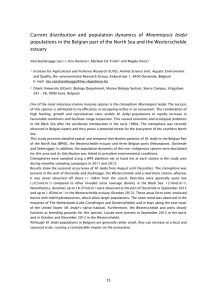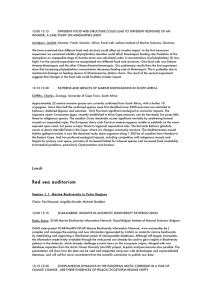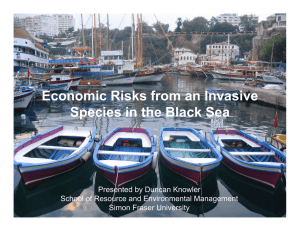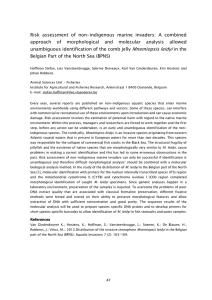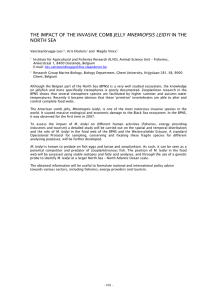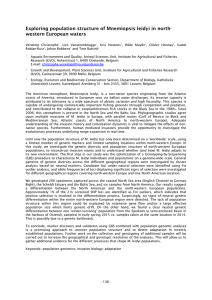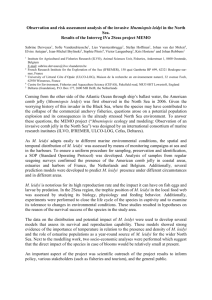Document 11853524
advertisement
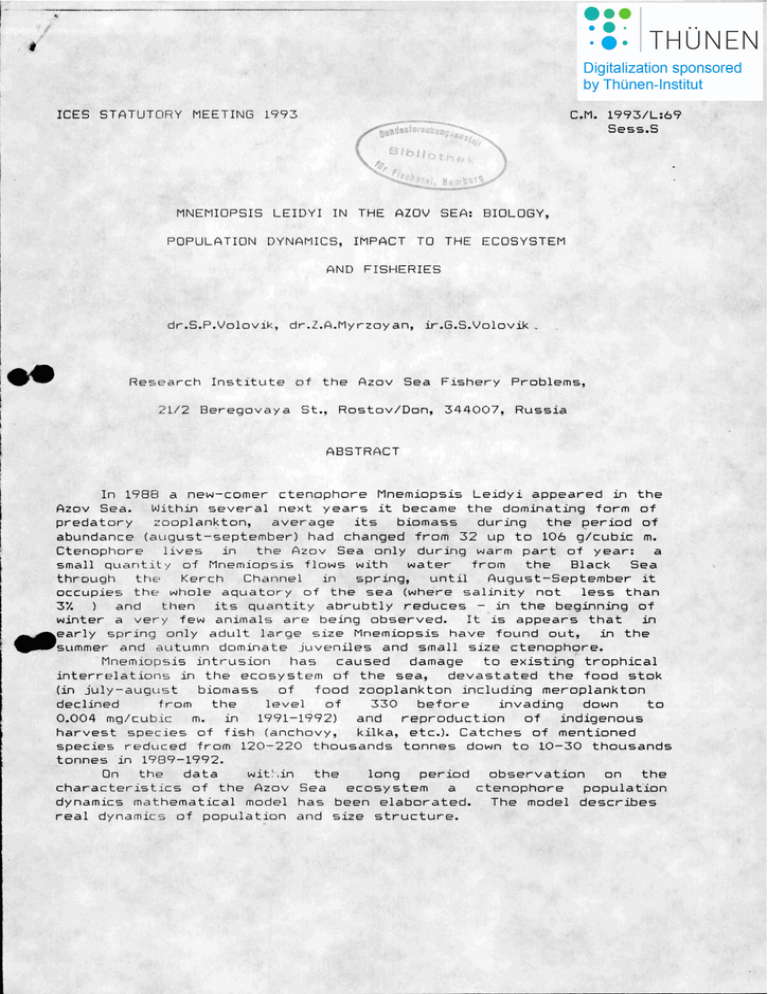
lCES STATUTORY MEETING 1993
C.M. 1993/L:69
Sess.S
MNEMIOPSIS LEIDYI IN
POPULATION
DYNAMICS,
THE
AZOV SEA:
IMPACT
TO
BIOLOGY,
THE ECOSYSTEM
AND FISHERIES
dr .S.P .Volov ik,
iee
I
I
dr .Z.A.Myrzoy an, ir .G.S.Volovik .
Research Institute of the Azov
21/2 Beregovaya St.,
lI
l
Sea Fishery Problems,
Rostov/Don,
344007, Russia
ABSTRACT
I
_
,
In 1988 a new-comer ctenophore Mnemiopsis Leidyi appeared in the
Azov Sea.
Within several next years i t became the dominating form of
predatory
zooplankton,
average
its
biomass
during
the per iod of
abundance (august-september) had changed from 32 up to 106 g/cubic m.
Ctenophore
Jives
in
the Azov Sea only during warm part of year:
a
small quantity of Mnemiopsis flows with
water
from
the
Black
Sea
through
the
Kerch
Charmel
in
spring,
until
August-September i t
occupies the whole aquatory of the sea (where salinity not
less than
3%
)
and
then
its quantity abrubtly reduces - in the beginning of
winter a very few animals are being observed.
It is appears that
in
earl Y spring only adult large size Mnemiopsis have found OLlt,
in the
summer and autumn dominate juveniles and small size ctenoph9re.
Mnemiopsis intrusion
has
caused
damage
to existing trophical
interrelations in the ecosystem of the sea,
devastated the food stok
(in july-aug Ist
biomass
of
food zooplankton including meroplankton
declined
from
the
level
of
330
before
invading
down
to
0.004 mg/cubic
m.
in
1991-1992)
and
reproduction
of
indigenous
harvest species o'f fish (anchovy,
kilka, etc.). Catches of mentioned
species reduced from 120-220 thousands tonnes down to 10-30 thousands
tonnes in 1989-1992.
On
the
da ta
wie,in
the
long
period
observation
on
the
characteristics of the Azov Sea
ecosystem
a
ctenophore
population
dynamics mathematical model has been elaborated.
The model describes
real dynamics of popula tion and size structure.
- 2-
.
o
"
.
.':'
'.
e
.
I,
I
The'Azov Sea is the extreme link in the Mideter~anean waterbody;
From time 'immemorial it was famous with its fish, stocks"a'nd even not
far aga the Azov Sea was, the most' productiVe' seCl the Wor-ld Ocean ov~r
(Moiseev,1969). It is a very· small sea~Its surface area is 37800
square ,km,
greatest depth is 14 m,
average depth is'8.5·m and its
volume amOLtnts' 320 cub'lc km~ • Temperature varies trom ~0.7 deg C in
January-February , 'up
to 26 \ .deg C (off-shore regions) and 30 deg C,
(coastal regions) in July-August ann'uallY. 'Currents in the shallow
Azov Sea are 'mostly tormed by the winds.,"
.
, The 'Azov Sea' is'a brackish water sea. Salinity of. the Azov Sea
changes trom, almost, full ~bsEm'ce of. salts (mineralization' 1 g/l' in
the estuary of the'Don River and the Easten ~art of.theTa~anrog Bay)
up to 15 -17. g/l in the Kerch Straits and' adjacent areas of' the, Azov,
where inflLlE?nce 01 water which' flows trom the Black Sea through the
Kerch Straits' is 'observed~'. Oscillation of average salinity 01 this
waterbody" is in' interval of.5 g/1 within last,70 years. During the
period , of, na'tural'" rivers
flow (before 1952) itsabsolute value
changed. trom 9~1. to,12.2 g/1.
The period after is charecterized 'by
very
.intensive usage. of
continental ',runoff for' the needs' of
agricul ture,
industry as weIl as municipal: and other anthropogenie:
activity,
av~rage salinity, varied
from 10 to 14 'g/1: 'Withinlast' ,
decade its vall.ie was only 11-12 g/1. Nevertheless, ,tl1is oscillatio~
.•.... of salinity, ,despite, of its small value,
is 'of vital importance for "
the biology of. the sea;' because it determines habitats,
taxonori'lic
composition and, productivity
of
the Azov, Sea biota' (yolovik, at
all,1993);
'"
' ..
Biota of .,the Azo~ Sea is characterized by rather wide str~cture
and formed by the representatives of genetically different "groups -"
freshwater-; seawater," bra'ckishwater and relict ,cc::implexes'- The special
:, peculiarity of
taxonomic 'structure' is not
a
great quantity
of
phytoplankton, zooplankton, zoobenthos and' f'ish species which form a'
great deal ,production. In spite of regulating' of . rivers flow;
productivity of biota has been staying on a, rather high' level even in
nearest past. Less than in' former days,
but. high' enough. Within the,
period before 1952· 'average biomass of phytoplankton: in off-shore
regions W<J5 3.0,
zooplankton - 0.34 g/cubic
m,
zoobenthos
'321 ,
g/square m, . in 1988:-:-1992' biomass varied, in, intervals: 0.5 - 2.3, 0;2
:- 0.4 g/cubiC: m 'and 194 -' 248 g/square 'm accordingly. Favourable
hydrological,
hydrochemical and feeding conditions as· weIl as large
surface area of spawning-grounds of the Azov.Sea basincaused forming
of weaIt:hy stocks of' harvest fish species. Witl1in the period 'of' bloom '
of the Azov Sea fishery (tl1e 30-s) it was caught about 300 thousands
tonnes'
of
fish;
more
than
a
half .-was anadromous', species
(sturgeon,herring) and semi-anadromous 'species (pike':"perch;- ,bream, '
sea:-roach)
of
fish •. After rivers' ,flow regulating-", ,: dealt with
destroying of reproduction mechanism of 'mentionedspecies" '. sea fish
species became dominating in fish
catches (goby,
anchovy,
Azov
kilka). The whole catches of
fish
were, not 'more ,than 150-250
thousands
tönnes~ During: 'last 'five 'years
a
newcomer' ctenophore
Mnemiopsis Leidyi has been appearing 'in 'the Azov Sea, - its causes tl1e
decrease of cathches down ,~to 10-30 thousands tonn~s. Anchovy and
kilka, which presented earlier 90-95 'l. of' catches, practically have
, lost, their f ishery importance.
.,
,In 19'88 a ,new orgilnism '':' etenophor-e Mnemiopsis Leidy i
was
found' out in the South part of the Azov,Sea.
It came from the Black
Sea, wher-eit had been brought in the beginning of 80-s with ballast
water' of . ships' from the ,,'Atlilntk Coast. of, Americ:a. This ~tenophore'is
meant as, onC? kind of biological' pollution of the; Azov 'Sea :, and within
a very shor,t time' pe~iöd -: during next 1989.-' Mnemiopsiscaused large
-scale .and manyfold: chang'es of pelagic part ~-of, bic::ita of ,the Azov Sea.
Sustainable ·study of mentioned newcomer;' ~ more exactly,
the study of
. its spread mechanism over' the
territory
of, the sea,
population
dynamics
and impact estimation to other levels of trophic chain - - is
being carried out since 1989 on
the data recieved" from . research
.....'"
I
....,.
,
"
'. ~
,',
'
3
I
'
expe'ditions (6-9' times per year) in off-shore regions and constantly
'provided'~coast testing' (fram
special' coast stations). Ctenophore
catches were' carried out by. plankton net (inlet diameter is 0.5 m) on
33 stations situated evenly over the aquatory ofthe sea;
PENETRATION AND ANNUAL CTENOPHORE DEVELOPMENT CYCLE. Possessed
iT1formation allows to affirm th~t I'1nemiopsis inhabits in' the Azov Sea
only within warm' year period. In 1989-1991· it was found out in April-'
. May, 1993- in the end of June, and it was observed only in the South·
region of' trie sea' adjacent to the Kerch Stniits~ In JulY":,,,August. it '
.did spread over almost the whole aquatory of the sea and in . the ,end
of August-September was
found
in the Taganrog Bay. In the end of
September its habitat was maximum (90-95% of the . seal,
everywhere,
where salinity was not less than 3 g/l' (Fig.1). During all the period
of obsenition in December-March there was' ,no a
smgle·· ctenophore
found out in all of
the 'regions free from fee,
inspite of its
abLlndanc:e in previous months. Inseveral cases: 1990, 1992 and 1993 Mnemiopsis was not observed even in the end of sring (May 1992) and
. beginning of summer (June_ .' 1993). A few' reasons
are known about
ctenophore mortality
in
the
Azov Sea during cold 'year period and
c:onsidered features of its biology
allows
to qualify
Mnemiopsis
Leidyi as· temporary
invader what
is not peculiar for Mnemiopsis
native habitat (Miller,1974,Deason,1982). Ctenophore penetration to
'
•
the Azov Sea takes place with intensive spring water flow through' the '
Kerch Straits fram 'the Black Sea. Usually
it happens' due
to
long-period' Southern winds which cause a bore from the Black Sea or'
afterstrong Nothern or EastenwiDds when compensational 'Black Sea
water
flo\o'J
takes pI ace. Both sit'uations. mentioned
above are
determined by meteo('ological ,conditions and change' fram yearto year.
Nevertheless, • for years of observation a-fact is\ common 'that firstly
e:tenophore', is met on a small aquatory· in the ,Southern. part·. of
the
sea. ' T aking into account thnt time of. penetration. is quite different
for eVE?ry year,
it is very interesting and important to consider a
mechanism of its spread over the Azov Sea. The dynamics of ctenophore
spread depends on conc:rete meteorological conditions and movement of
the' ,sea wa ter,
because constant. currents are not' usual for the' Azov
, Sea' and dyna'mics
of
region .. water exchange. is defined, by' wind
ae:tivity.
That
is why,
some years ctenophore developed very
intensively in June-beginning of
July, mostly
in' the Easten part
. ,(1989,1990) or in
the' central part (1991,1992) of th'e s'ea and anly
afterwards it spread to other' regions in' September.
.....
Ctenophore usually
spread' over the
territory of the Azov Sea '
This property. allows 'it to' impact hardly to suinmer-autumn
. . very fast.
plankton. community ,which is a' food for Mnemiopsis~ BecausE?, of srrall'
depth of. the sea,
ctenophöre inhabits all' layers ofwater.Ttlere' is',
no any found pec:uliarities of vertical movement of Mnemiopsis Leid}'i.
in the Azov Sea.
.
"
•
'.
.,
differs ,within a year period.
POPULATION SIZESTRUCTURE very
When population development. starts' (in spring-summer beginnig), ..
mostly adul t animals are met.
Their size is 20-55 mm. Juveniles and
larväe are usually absent.
Quantity of juveniles (less than 5 mm) is
about 101.. ,rn the end of summer and in autumn the.base.of ctenophore
popula tion is small and, middle size (5-15 mm) anirrials~ big ctenophore
'
is very
rarely met this time (Fig.2). The maximum size is not mor:e
than 70-80 mm.
. , '
, CTENOPHORE BIOMASS is rather,' different from year' to ~e~~, as
well as within one year 'and depends on region of
the
sea. Biomass
also, depends on penetration time from the Black, sea~ . 'spread ,Qver the
,terr-itory .of the Azov Sea and quantity of available food.
In common,
i t ' is possible
to mention two biomass dyn'amics 'scenarios: early
(April 1989) and late (May-:June 1990 - '1993)' penetration ,to the Azov
Sea thruogh the Kerch Straits. In the beginning of its livmg in the
Azov Sea, a very few' animals was observed in the ' region., adjacerit
to
the Kerch Straits.
'
6'.'
"
,
4 -
..
1990
1992
..
July
October
Fig.1. Distribution and biomass of Mnemiopsis leidyi in
the Azov sea
r.:::::'l
~
single
animals
r:::::::J
0,1-15
~
15-50
.g/cub.m w.w.
- 5 -
May
August
••
October
Fig.~Mnemiopsis
~
<5 mm
population size composition in the Azov sea
.~
1~-25 mm
~
>25mm
- 6 -
. Table 1
Mnemiopsis IBidyi biomass in the Azov sea
( g/ cub.m w;w;)
. I
montbt·
years
'VI
VIII
VII
IX
•
-----=...-----~------:;-----.,;:.--_._-_.:-
the Az ov .sea
_ _ 989
7.J4-283 t O
o.t I -77 t 5
*)
7~0-I9I~I
106,0
11,3
60,7
6 J O -141.J0_ 6.J0-13110 9..&.-433.10 210 -g80.1Q
44,0
68,0
43,0
39,0
_°12 - 14,8 . 3.J0 -199.10 3.10 -318.10 710 -285..20
3,1
68,0
69,2
102,0·
°
I tO - 241.J 0 110 -307.JQ 1.1°-129tO
57,0
51,0
32,4
r990
1991
r992
-_ -
----- -
......
..
1989
°
_990
°
95 t 5-728 t O 4,0 - 95.J6
38,2
226,0
49,0 ,
~O -147.10 4520 -298 2° 23 t O-397 10_
123,0
45,0
54~0
14 1 0-505.J° 40,0-583 t O 8 t O - 37.J0
154,0
15,0
177,0
1.J0 -424 1 0 2.10 - 270.J 0 ~O-6120
66,4
32,4
123,0
;'
1991
°
°
1992
°
°
------ ._------------Footnote:
8,0 - 6~.13
25,2 .
1.J 0 - 44 t O.
7,0
4.10 - 37.1°.
15,0
-L 0 "7 74..20
15,3
--,~-
the Taganrog bay
16,5 -58.J0
*)
°
x
_.----
intervall average; *) - Da data
-
7 -
When Mnemiopsis appear-s in Apr-il (I scenar-io), the first par-t of
summer- and mid-summer- is char-acter-ized by ver-y fast incr-easing of its
biomass (0.07-0.35 in May - 11-43
9
wet
weight/cubic
m
in
June,
maximum
value
is
78141
9
wet weight/cubic m.
When ctenophor-e
appear-s in the end of May-June (Il scenar-io),
its abundance has been
obser-ved
only.in July.
By this time ctenophor-e inhibits only on 401.
of the aquator-y (I scenar-io - 801.).
Quantity of Mnemiopsis incr-eases
abr-uptly
in
the
beginning
of
summerfr-om 3 g wet weight/cubic m
"biomass to. 56-68 9 wet weight/cubic m,
maximum value 199-241 . g
wet
weight/cubic m (T abl.l), aver-age value for- the sea is 62 9 wet weight
/cubic m.
In
Octoberbiomass
r-educes
in
the
sea
as
weIl
as
in the
T aganr-og
Bay
(16
and 38 9 wet weight/cubic m)(T abl.1).
If
ctenophor-e biomass in any one r-egion is compar-ed,
it
will
be
seen
that
within
one
month
per-iod
Mnemiopsis
quantity will r-each its
maximum and then will r-educe ver-y r-apidly (Fig.1).
This pr-ocess with
taking into consider-ation the absence of natur-al ctenophor-e pr-edator-s
is defined by food dynamies.
So, maximum of Mnemiopsis biomass has been obser-ved in August or'ieptember-.
The aver-age biomass pr-oduced dur-ing vegetation per-iod
in
ihe
Azov
Sea
is
estimated
as
22.6 million tonnes of wet weight.
Createst ctenophor-e stock (32 million tonnes) was mar-ked in
1989.
A
~end of r-educing of year- stock is being found out.
Aver-age quantity
ci Mnemiopsis population for- all the r-egions var-ies 0.5-7.4 thousands
p'r- squar-e meter- in Jul y and up to 33 thousands in August.
All mentioned above data
means
that
intensity
of
ctenophor-e
dlvelopment
in
the
Azov
Sea
exeeds
ver-y
much its own habitat cc.astal r-egions of Amer-ica
(3-100/cubic
m-Mounfor-d,1980,Deason
and
Snlyda,1982,
Kr-emer-,1976,
Miller-,1974) and equals development level
ot the Black Sea (Vinogr-adov,1989,Shushkina,Musaeva,1990,Shushkina at
a::,1991).
Pr-ocess of ctenophor-e feeding was
not
specially
studied,
but
libr-ar-y
data
says
that
its
r-ation
does
not
differmuch
on
cOlposition and quantity
forthe
Black
Sea
fr-om
native
habitat
(Vitogr-adov,1989, Tsikhon-Lukanina at all,1991, Shushkina at all,1990,
Kr-ener-, 1976, Lar-sen 1988, Reeve at all, 1989).
The Azov
Sea has its specifical hydr-ochemical composition. That
Ü~ \hy,
the data on ctenophor-e chemical composition r-ecieved
dur-ing
samjling in the Azov Sea is of vital impor-tance.
Dr-y weight is about
21. of wet weight, pr-otein is 0.171. of wet weight, ther-e ar-e 17 amino
acid~ in it.
Among micr-oelements dominate Cr--7.9, Co-0.016, Hg-O.22,
CU-4l.5,
Pb-1.6,
Ni-2.8,
Ba-7.6,
Be-O.03,
Sr--300, Al-56, Fe-45.5
mic:r-ol,... amm/g dr-y weight.
'0 estimate ctenophor-e feeding out impact to
plankton community
01
th,'
Azov
Sea would be possible with the help of data befor-e and
Ci (er- i:s
invasion
(T ab1.2).
A
fact
is
wor-th
under-lining
that
i tf'nsity
of
zooplankton development in spr-ing has incr-eased due to
?I )'i;ence of ctenophor-e and decr-eased in summer--autumn
(in
mor-e
than
;)0
timl!s)
due to its abundance.
Decline of taxonomie qLJantity and
."t.i.ze str-u,tur-e
of
zooplankton
has
stated
dur-ing
the
per-iod
of
.'tenophor""\'
Ibloom".Compar-ing
season oscillations of population size
;" tr-uctur-e,
i t has become possible
to
ascer-tain
that
the
biggest
,amage
to
Azov
zooplankton
lS
caused by Mnemiopsis juveniles and
ar-vae.
Wealthy food
r-esour-ces
of
the
Azov
Sea
wer-e used mostiy by
anchovy and ~: ilka which for-med pr-oduction up to 1.8
million
tonne,;
biomass
of
theirpopulation
togetherr-eached
1.7 million tonnes ,
(Volovik,
1986'\.
After- its penetr-ation to the Azov
Sea
Mnemiopsis
became the main r-ival on feeding out of food r-esour-ces and, possibly,
the dir-ect pr-edator- on anchovy lar-vae and juveniles. Within the whole
per-iod
of
obser-vation only on sever-al stations wher-e ctenophor-e was
pointed out some quantity of anchovy spawn and lar-vae was found. As a
r-ule,
ther-e
was
no
anchovy
spawn
or- lar-vae in the r-egions which
Mnemiopsis inhibited.
The feeding out of fish
(anchovy
and
kilka)
-
8 -
Table 2
Zooplankton biomass before and after Mnemiopsis
introduction to the Azov sea (mg! cub~ m w~w~)
years
. - -.- - IY
1979-1987
1989
.--
1990
1991
1992
96
6 - 517
162
~g -862
283
6 - 620
188
I - 350
69
---
97
1979-1987
1989
20 - 310
108
1990
56 - 712
277
1991
6 - 724
196
192
7 - 243
48
..
monthl
.. YIAzov sea
Y
the
298
YTI
Ylll
X
298.
240
107
'2 - 303 I - 87 9.1 02 '- ..§6 0..21 -593
77
9
17
71
92 -4792 4-654 0..21_-394 . ~02 - 12 0 2 04-59 .
970
159
2
42
11
. 89 -4088 8 - 862
0;01 - 19 0 2 04 -11
- 1184
96
I
I
I - 5180
121-2390 4 - 408 0 2 04 - 3
I - 26
-1079
89
844
I
10
-
445
_.-
-
the Taganrog bay
269
592
518-3713 19 - 626
1829
238
63~ 669 13 - 571
403
132
_10-3284 11=3284_
730
730
11 -1606 19-1045
880
302
750
637
Q.l1 -186 . 3 -1944
46
474
3 - 465 O2°1 -3442
620
184
.'
0 2 4 - 107
16-4320
1006
40
29 -300
2 - 66
27
136
874
14 -998
280
2 - 567
260'
0 25-395
109
3- 273
56
-----_. -----------------------Footnote:
intervail average
-
-------'
20ü
1...·-·
~~U
'1"",-°,
.lUU
Graphie was built for I scenario
.Penetr a tion da y - 1.06
:
,
- ·10 ,
food
caused a
lack
of
necessa~y accumulated. ene~gy what did it
impossible for fish to mig~ate, to winte~ and . to
develop sexual
p~oducts. That
is
why,
st~ong changes wer~ '~egist~ated as weIl as
dest~iying of population ~ep~oduction,
decline of
their. p~oduction
(kilka - 4-5· timesj anchovy - mo~e than 10 times), populaÜon biomass
and ha~vest stocks. All mentioned has caused demage ·to la~ge-s~al~
fishe~y•. Losses
f~om Mnemiopsis int~oduction a~e app~aised at 30-4(;.
million US$ annually fo~ the Azov Sea. The simila~ figu~e fo~. thf' . .
Black Sea is 240 ·millionUS$(Caddy,1991).
A Mnemiopsispopulation dynamics
mod~l
was elaborated
. for
development intensity p~ediction and ctenopho~e influence to the Azov"
Sea ecosystem and populations of harvest fishes estimation. The model
desc~ibes
ctenopho~e sp~ead
along
the w,ate~body, feeding,
food
assimilation; ~espiration and extrac:tion, rep~oduc:tion and mo~tality,
biomass and population dynamics' and othe~ p~ocesses (Fig.3)., Firstly
the model was buHt on the methodology used
by
ame~ic:an scientists
'(Kremer,1975,1977, K~eme~,Reeve,1989, Reeve at all;1989), but ~esults.
we~e w~ong fo~ conditions'of the Azov Sea,
b~cause there is' no usual
ctenopho~e food enough:
It was necessa~y to elabo~ate feeding model
fo~ the Azov Sea conditions.
It was done on
existed' lite~a~y da ta
(Vinogradov
at
ci11,1989;. Shushkina at a11,1990, Tsikhon-Lukanina at
a11,1991;
Zaika,1990) •. An idea that Mnemiopsis feeds on mezoplankton
o~ganisms ,(including
me~oplankton) p~oved
by mentioned scientists
from the Black Sea Dceanological Institute named afte~ Shirshov. was
used. Ve~ification of the model with a11 the 'facto~s has shown 'that
ctenoPho~e population oscillations within the pe~iod of its living in '
the Azov Sea have two o~ thr:ee maxximum (Fig.3). ' Fo~ eve~y of them a'
special population size st~uctu~e is typical. Natu~al sampling in the
Azov Sea
p~oved' only
size' - weight cha~acte~istics of. Mnemiopsis
population.
In· essential
habitat
Mnemiopsis
population' has one
1 maximum in season population dynamics (K~eme~,1979). ,
~
Carried out
resea~ch convinces in necessity.of further study of
Mnemiopsis biology in' the Azov Sea basin•. This is the' only
way
to
solve. the p~oblem of'ecosystem protec:tion from harmful.impact of this
invader.
.
RFERENCES
of
'Natural
Resources.
Caddy J.F.
1992
Rehabilitetion
(Environmental management and protection of the' Blac:k Sea. Technical
Romania. Working group Ir.
Expert Meeting;
20-21.05.92,
Constanza,
Background Document). FAD, GFCMjp. 22.
Deason E.E. 1982 Mnemiopsis Leidy i (Ctemophora) in Narragan'sett
Bay,
1975-1979. Abundance,
size
composition and estimation· of
grazing•. Estuar. Co ast. Shel f. Sei.' 15(2):121-134.
Deason E.E. and T.J.SmaYda 1982 Ctenopho~e:-Zooplankton-PhytoPlari-.
kton Interac:tion in Narragansett Bay,
Rhode Island,
USA. J.Plankton
Res. 4(2): 219-236.
".
Kreme~ P.
1975 The Ecology of the Ctenophore Mnemiopsis Le~dyi
in Narragansett Bay. Rh.D.Thesis.Univ. Rhode Island,' USA, p.33.
Kr'eme~ P.
1976 Population Dynamic:s and Ecological Energetics of
a· Pulsed' Zooplankton . Predator the Ctenophore Mnemiopsis Leidyi.
Wiley,
Martin (ed.). Estuarine Processes. Vol.1. Uses, Stresses and
Adaptation to the Estuary. ACademic Press: New York:197-215.
Kreme~ P. 1977 Respi~ation· and Exc:~etion by' the Ctenophore
Mnemiopsis Leidyi. Mar.Biol. 44,1:43-50.
.'
Kreme~ P.
and Reeve M.R. 1989 Growth Dynamic:s of a
Ctenophore
(Mnemiopsis) in Relation to Variable Food Supply~ H. Carbon Budget
.
and Growth Model. J.Plankton Res. 11:553-574.
Larson R~J. 1988 Feeding and Functional Morphology of the Lobate
Ctenophore Mnemiopsis -'1ccradyi. Estuarine' Coastal . Shelf.
Sei.
27,5:495-:-502. .
Miller R.J. 1974
Distribution and
Biomass of
an Estuarine
-
11 -
Ctenophore Population, Mnemiopsis Leidy i (A.Agassiz). Chesapeake Sc:i..
15:1-8.
Moiseev P.A. 1969 Biologic:al Resourc:es of World Oc:ean.
Mosc:ow.
338pp.
Mounford K.1980 Oc:c:uranc:e and Predation by
Mnemiopsis Leidy i in
Barnegat Bay, New Jersey. Estuar. Coast. Mar.Sci. 10:393-402.
Reeve M.R.,
Syms
M.A.,
Kremer
P.
1989 Growth Dynamic:s of a
Ctenophore (Mnemiopsis) in
Relation
to
Variable
Food
Supply.
I.
Carbon biomass,
feeding,
eggs produc:tion,
growth and assimilation
effic:ienc:y. J.Plankt.Res. 11,3:535-552.
Shushkina E.A.,
Musaeva
E.I.
1990 Struc:ture
of
Epipelagic:
Zooplankton Community and its Changes
Related
to . the
Envasion
of
Mnemiopsis Leidyi in the Blac:k Sea. Oc:eanology, 30,2:306-310.
Shushkina E.A.,
Nikolaeva G.G.,
Lukasheva T.A. 1990 Changes 'in
the
Struc:ture
of
the .Blac:k Sea
Plankton
Community
at
Mass
Reproduc:tion
of
Sea
Gooseberries
Mnemiopsis
Leidy i
(AgassiZ).
Oc:eanology, 51,1:54-60.
Tsikhon-Lukanina E.A.,
Rezmic:henko O.G.,
Lukashova
T.A. 1991
Quantitative
Aspec:ts
of
Feeding in
the
BlaC:K Sea
Ctenophore
Mnemiopsis Leidyi. Oc:eanology, 31,2:272-276.
Vinogradov M.E.,
Shushkina
E.A.,
Musaeva E.I.,
Sorokin P.Yu.
1989 Ctenophore Mnemiopsis Leidy i (A.Agassiz)
(Ctenophora;Lobate)
new set tiers in the Blac:k Sea. 0c:eanology,XXIX,2:293-299.
Volovik S.P. 1986 Main Direc:tion of Changes
of
the
Azov
Sea
Ec:osystem
Relate
to
Development
of Ec:onomy in its Basin. Vopr?sy
Ikhtiologii, 26,1:· 33-47.
Volovik S.P.,
Dubinina V.G.
and Semenov A.D. 1993 Hydrobiologr
and Dynamic:s of Fishing in the Sea of Azov.
FAD Studies and Reviews,.
N64:5-59.
